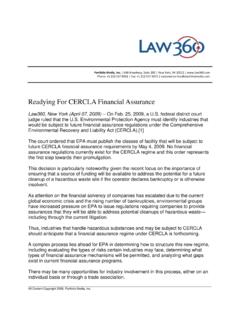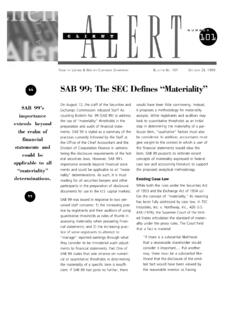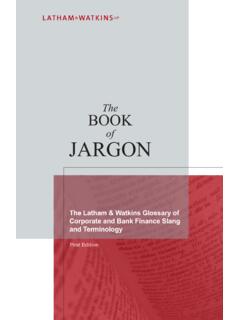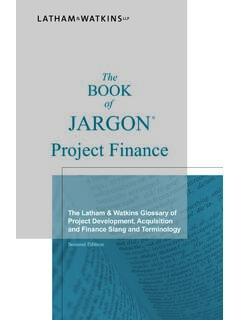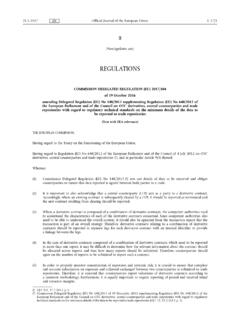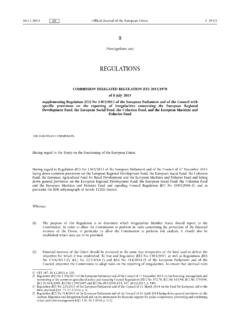Transcription of COMMISSION DELEGATED REGULATION (EU) 2016/ 522 - of …
1 II (Non-legislative acts) regulations COMMISSION DELEGATED REGULATION (EU) 2016/ 522 of 17 December 2015 supplementing REGULATION (EU) No 596/2014 of the European Parliament and of the Council as regards an exemption for certain third countries public bodies and central banks, the indicators of market manipulation, the disclosure thresholds, the competent authority for notifications of delays, the permission for trading during closed periods and types of notifiable managers' transactions (Text with EEA relevance) THE EUROPEAN COMMISSION , Having regard to the Treaty on the Functioning of the European Union, Having regard to REGULATION (EU) No 596/2014 of the European Parliament and of the Council of 16 April 2014 on market abuse and repealing Directive 2003/6/EC of the European Parliament and of the Council and COMMISSION Directives 2003/124/EC, 2003/125/EC and 2004/72/EC (1), and in particular Article 6(5), Article 12(5), Article 17(2) and (3), and Article 19(13) and (14) thereof, Whereas.
2 (1) REGULATION (EU) No 596/2014 confers on the COMMISSION the power to adopt DELEGATED acts in a number of closely related matters pertaining the exemption of certain third countries public bodies and central banks from the scope of application of that REGULATION , the indicators of market manipulation, the thresholds for the disclosure by emission allowance market participants of inside information, the specification of the competent authority for the notification of delays in the public disclosure of inside information, the circumstances under which trading during closed period can be permitted by the issuer and the types of notifiable managers' transactions. (2) Member States, members of the European System of Central Banks, ministries and other agencies and special purpose vehicles of one or several Member States, and the Union and certain other public bodies or persons acting on their behalf should not be restricted in carrying out monetary, exchange-rate or public debt management policy insofar as those operations are undertaken in the public interest and solely in pursuit of those policies.
3 (3) An exemption from the scope of REGULATION (EU) No 596/2014 for operations undertaken in the public interest may, in accordance with Article 6(5) of REGULATION (EU) No 596/2014, be extended to certain public bodies charged with, or intervening in, public debt management and to central banks of third countries when they fulfil the relevant requirements. For that purpose, the COMMISSION prepared and presented to the European Parliament and to the Council a report assessing the international treatment of certain public bodies charged with, or intervening in, public debt management and of central banks in third countries. The report included a comparative analysis of the treatment of certain bodies and central banks within the legal framework of third L 88/1 Official Journal of the European Union EN (1) OJ L 173, , p.
4 1. countries, and the risk management standards applicable to the transactions entered into by those public bodies and central banks in those jurisdictions. The report concluded in the comparative analysis the appropriateness of the extension of the exemption for transactions, orders or behaviour, in pursuit of monetary, exchange rate or public debt management policy, also to certain public bodies and central banks of those third countries. (4) A list of exempted public bodies and central banks of third countries should be set out and reviewed whenever necessary. (5) It is essential to specify the indicators of manipulative behaviour relating to false or misleading signals and to price securing laid down in Annex I to REGULATION (EU) No 596/2014, in order to clarify their elements and to take into account technical developments on financial markets.
5 Therefore, a non-exhaustive list of such indicators including examples of practices should be provided. (6) For some practices, additional indicators should be identified as they can respectively clarify and illustrate such practices. Those indicators should neither be deemed exhaustive nor determinative and their relations to one or more examples of practices should not be deemed limitative. The examples of practices should not be considered to constitute market manipulation per se, but should be taken into account where transactions or orders to trade are examined by market participants and competent authorities. (7) A proportionate approach should be followed, taking into consideration the nature and specific characteristics of the financial instruments and markets concerned.
6 The examples may be linked to and illustrate one or more indicators of market manipulation as provided in Annex I to REGULATION (EU) No 596/2014. As a result, a specific practice may involve more than one indicator of market manipulation laid down in Annex I to REGULATION (EU) No 596/2014 depending on how it is used, and there can be some overlap. Similarly, although not specifically referenced in this REGULATION , certain other practices may illustrate each of the indicators set out in this REGULATION . Therefore, market participants and competent authorities should take into account other unspecified circumstances that could be considered to be potential market manipulation in accordance with the definition set out in REGULATION (EU) No 596/2014.
7 (8) Certain examples of practices set out in this REGULATION describe cases that are included in the notion of market manipulation or that, in some respects, refer to manipulative conduct. On the other hand, certain examples of practices may be considered legitimate if, for instance, a person who enters into transactions or issues orders to trade which may be deemed to constitute market manipulation may be able to establish that his reasons for entering into such transactions or issuing orders to trade were legitimate and in conformity with an accepted practice on the market concerned. (9) For the purposes of listing examples of practices referring to indicators of market manipulation as provided in Annex I to REGULATION (EU) No 596/2014, cross-referencing in Annex II to this REGULATION includes both the relevant example of practice and the additional indicator associated with that example.
8 (10) For the purpose of indicators of manipulative behaviour set out in this REGULATION , any reference to order to trade encompasses all types of orders, including initial orders, modifications, updates and cancellations, irrespective of whether or not they have been executed, of the means used to access the trading venue or to carry out a transaction or to enter an order to trade and of whether or not the order has been entered into the trading venue's order-book. (11) Emission allowance market participants are a specific sub-set of the participants in the emission allowance market. Among the participants in the emission allowance market, those above certain minimum thresholds should qualify as emissions allowance market participants, and the requirement of public disclosure of inside information should apply only to them.
9 Therefore, those minimum thresholds should be clearly established. (12) Following the definition of inside information under Article 7(4) of REGULATION (EU) No 596/2014, an emissions allowance market participant has to assess on a case by case basis whether the information under consideration meets the criteria of inside information. This implies that an emissions allowance market participant is not expected to publicly disclose all information about its physical operations. The emissions allowance market participant should properly assess the information at stake, taking into account the market circumstances and other external factors that may have a price effect on an emission allowance at the particular point in time when the information arises.
10 L 88/2 Official Journal of the European Union EN (13) The exemption set out in Article 17(2) of REGULATION (EU) No 596/2014 excludes from the definition of emissions allowance market participant those participants in the emission allowance market where the instal lations or aviation activities they own, control or are responsible for, have had in the preceding year emissions not exceeding a minimum threshold of carbon dioxide equivalent and, where they carry out combustion activities, have had a rated thermal input not exceeding a minimum threshold. Hence, the minimum thresholds should relate to all business, including aviation activities or installations, which the participant in the emission allowance market concerned, or its parent undertaking or related undertaking owns or controls or for the operational matters of which the participant concerned, or its parent undertaking or related undertaking is responsible, in whole or in part.

